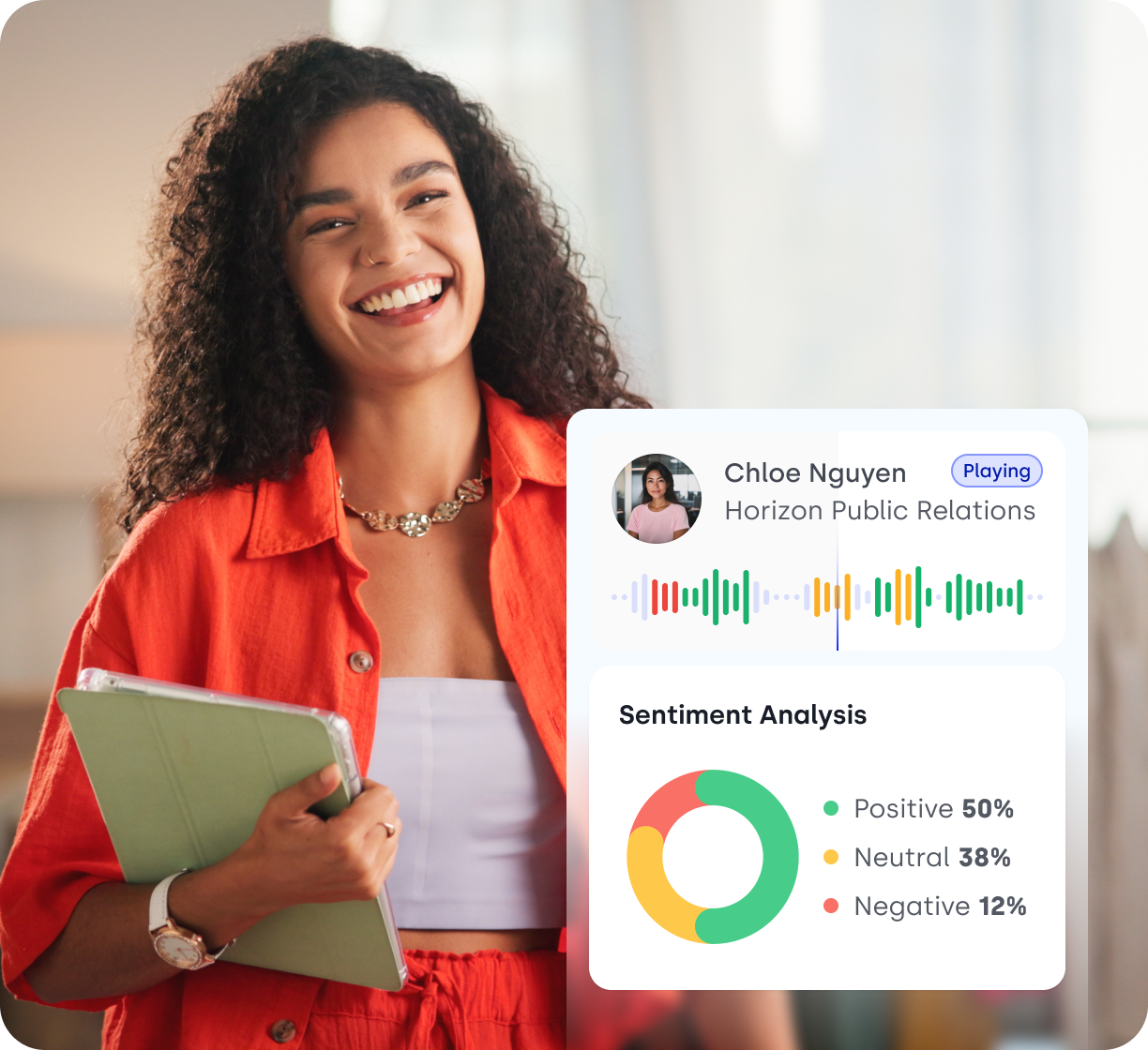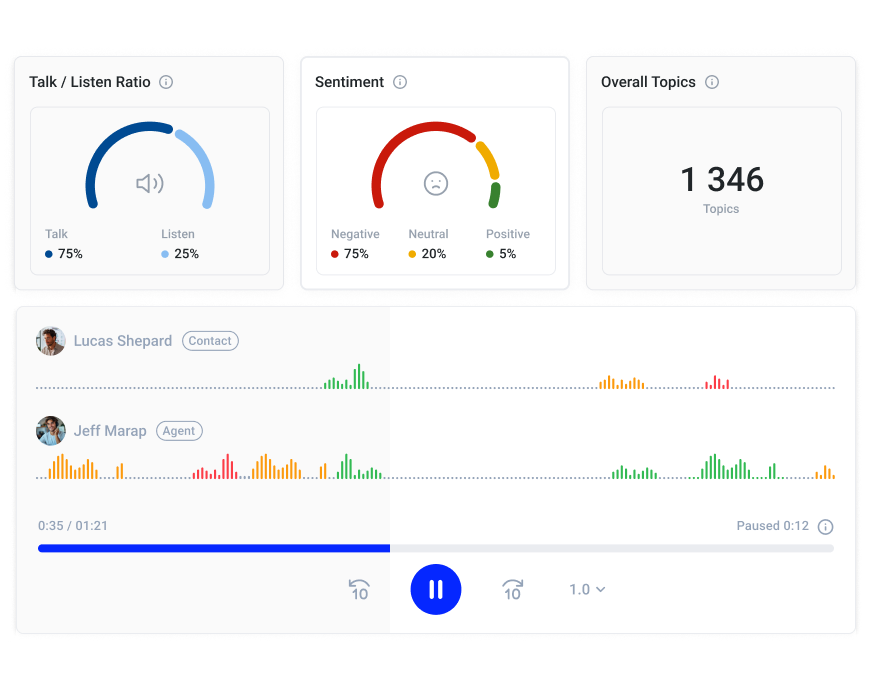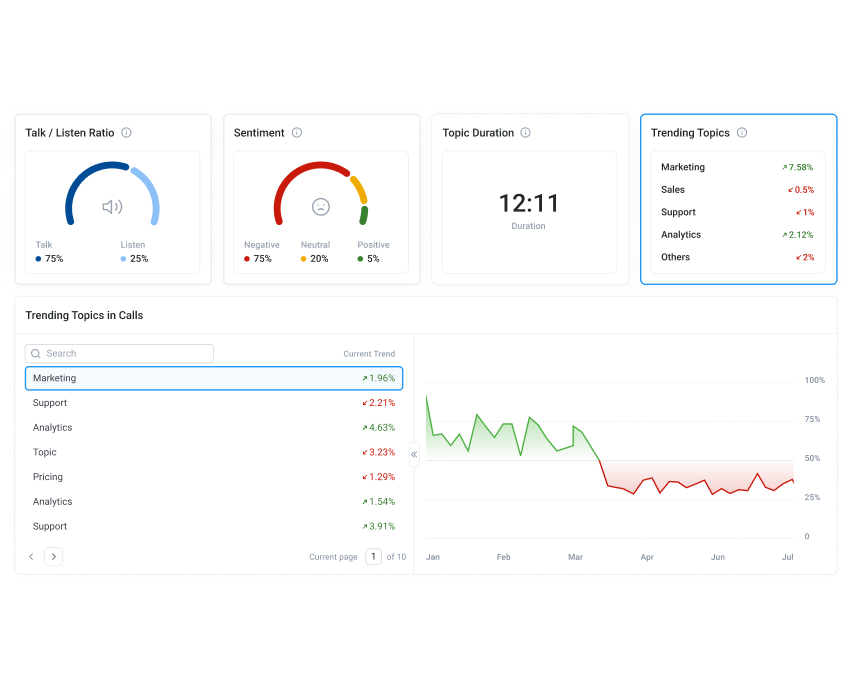- Solutions
- Solutions primary
- BY TEAM
- BY INDUSTRY
- BY USE
- BY SIZE
- View all solutions
- Solutions secondary
- Solutions primary
- AI
- Features
- Features primary
- Most popular
- first column
- second column
- third column
- fourth column
- View all features
- Most popular
- Features secondary
- Choosing the right plan
- Features primary
- Integrations
- Integrations primary
- MOST POPULAR
- first column
- second column
- View all integrations
- NEW
- first column
- second column
- View all integrations
- MOST POPULAR
- Integrations secondary
- Integrations primary
- Pricing
- Resources
- Resources primary
- Most popular
- first column
- second column
- third column
- Most popular
- Resources secondary
- Latest Blogs
- Try CloudTalk
- Resources primary
- Partners
Get Instant Customer Insights with Voice Call Sentiment Analysis
Uncover the emotions behind every conversation–what’s working, what’s not, and what to do next. Track customer emotions in real time to deliver better service, support agents on the spot, and improve customer experience with data-driven insights.

We’ve helped thousands of global companies
Case studies featuring customers who are building faster.
What is Voice Call Sentiment Analysis?
Voice call sentiment analysis is a technology that call centers use to listen to conversations between agents and customers and determine whether the customer’s message shows a positive, neutral, or negative emotion.
It uses tools like Artificial Intelligence (AI), natural language processing (NLP), and machine learning, detecting emotions such as happiness, frustration, sadness, or neutrality.
This type of analysis helps businesses understand whether customers are satisfied or not, identify opportunities to improve service, and personalize responses during the call.
In summary, sentiment analysis allows businesses to provide more human, efficient, and tailored support based on what the customer is truly feeling.

How Does Voice Call Sentiment Analysis Work?
First, it transcribes spoken words into text using transcription technology. Once the text is generated, advanced machine learning and natural language processing (NLP) algorithms analyze the voice call to determine its emotional tone.
The analysis doesn’t just focus on the words; it also examines the tone of voice and speech patterns. Artificial intelligence (AI) can detect, for example, whether a customer is speaking calmly, angrily, or happily, which is crucial for understanding their emotional state.
After processing the information, the system classifies the call as positive, negative, or neutral, based on the predominant sentiment throughout the conversation. This all happens in real-time, allowing businesses to respond quickly.

Solve Issues Before They Escalate
Real-time emotional data helps agents quickly identify if a customer is satisfied or frustrated, allowing them to adjust their responses instantly. This prevents negative outcomes by addressing issues before they escalate, ensuring a better customer experience.

Turn Negative Sentiment into Growth Opportunities
Monitor and evaluate how your agents handle calls to coach them more effectively. Act in time when customers show negative sentiment or provide relevant feedback to help agents improve their communication and conflict-resolution skills.

Elevate Customer Satisfaction by 20% Using Data Insights
Access detailed reports and trends to guide business decisions. Identify customer interaction patterns, pinpoint improvement areas, and adjust strategies accordingly. This approach helps proactively address issues and improve service efficiency, boosting customer satisfaction.

Top Use Cases of Voice Call Sentiment Analysis
- Smarter Script Tuning: By analyzing how customers react to specific phrases or approaches, sentiment data helps refine call scripts to ensure they lead to clearer, more empathetic, and more effective communication during customer interactions.
- Call Monitoring with Real-Time Insights: Supervisors can detect negative emotions during live calls and intervene immediately, ensuring a better customer experience and preventing potential dissatisfaction or conflict.
- Optimizing Customer Support Processes: By analyzing patterns of call sentiment across customer interactions, you can identify recurring issues or bottlenecks in your processes. You can use these insights to improve workflow and fix common issues.
- Proactive Customer Retention: Sentiment insights help identify early signs of customer dissatisfaction, allowing businesses to take proactive steps—like offering personalized deals or follow-ups—to reduce churn and build stronger relationships.

How to Implement Sentiment Analysis in CloudTalk?
- Log in to your CloudTalk account.
- Go to Account Settings from the Dashboard.
- Under AI Features, select Sentiment Analysis.
- Toggle it on and customize settings to fit your needs.
- Click Save to activate sentiment analysis.

Frequently asked questions
Everything you need to know about the product and billing.
What are the essential elements of a sentiment analysis solution?
A sentiment analysis solution uses NLP, machine learning, and real-time analytics to detect emotion, classify calls, and improve customer interactions.
What is the sentiment analysis model of voice?
Voice sentiment analysis uses AI to assess tone, pitch, and words, helping businesses detect if a customer is satisfied, frustrated, or neutral.
What is the sentiment analysis of phone calls?
Phone call sentiment analysis detects emotional tone in real time or after calls, helping businesses respond better to customer emotions.
How is customer privacy maintained in call center sentiment analysis?
Contact center sentiment analysis protects privacy through encryption, access control, anonymization, and compliance with regulations like GDPR.
Is sentiment analysis effective for both inbound and outbound calls?
Yes, sentiment analysis works for inbound and outbound calls, helping agents detect emotions and respond proactively to improve communication and service.
How can voice sentiment analysis improve the customer experience?
Voice sentiment analysis helps agents detect emotions in real time, adjust responses, resolve issues early, and boost satisfaction and loyalty.
How can businesses get started with sentiment analysis in a call center?
Start by choosing call center sentiment analysis software like CloudTalk with sentiment analysis, set it up to track calls, and train agents to use insights to boost customer satisfaction.
What is the voice of customer sentiment analysis?
Voice of Customer (VoC) sentiment analysis collects and interprets customer feedback to understand emotions, opinions, and attitudes about a brand.
What is the sentiment analysis of incoming calls?
Sentiment analysis of incoming calls evaluates customer emotions in real-time, helping agents adjust responses to improve satisfaction and resolve issues quickly.
What are the three types of sentiment analysis?
The three main types of sentiment analysis are emotion-based, fine-grained, and aspect-based, helping businesses understand emotions, details, and specific opinions.



Still have questions?
Can’t find the answer you’re looking for? Please chat with our team.
Ready to get started?
Join over 4,000+ modern companies that already trust CloudTalk to have MORE and BETTER calls.





















